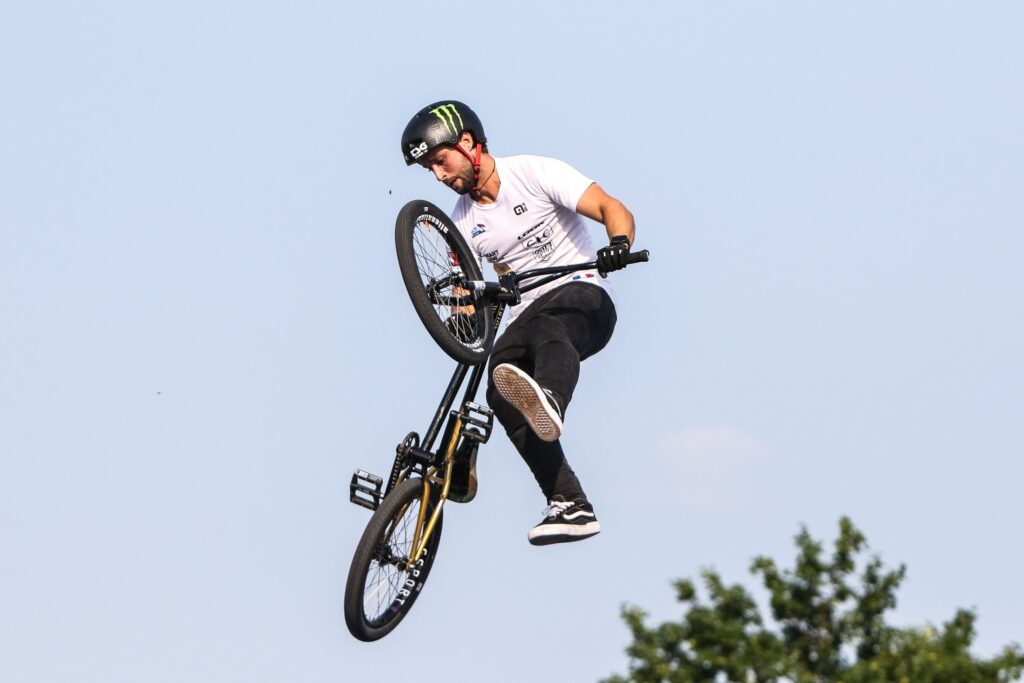Tracks approximately 400 meters long, uneven and full of obstacles and challenges, such as bumps, ramps, hills, sharp bends, ditches and undulations. BMX Freestyle Cycling is excitement and danger from start to finish. Continue here to find out all about BMX Freestyle Cycling!
Aopen your Betano account and get up to 1,000 reais in bonuses.
Payments via PIX, live games and super odds!
Click here to open your account!
All about BMX Freestyle Cycling: what is it?
Popularly known as Bicicross, BMX is a cycling discipline that involves racing bicycles on dirt tracks;
To overcome these obstacles, cyclists need not only agility and speed, but also advanced skills in radical maneuvers;
The practitioners take their maneuvers seriously to ensure that they are executed to perfection.
These maneuvers are performed with 20″ rim bikes, allowing for impressive jumps and spins in the air, constantly defying gravity.
This sport is divided into two categories: Racing and Freestyle;
Read to the end to find out all about BMX Freestyle Cycling!
All about BMX Freestyle Cycling: history of the sport
BMX, also known as bicicross, is the most recent form of cycling.
It emerged between the 1960s and 1970s, a time when the sport’s most traditional disciplines – road and track cycling – were already part of the Olympic Games;
BMX was born from the admiration of young Americans for MotoCross. Wanting to imitate their idols’ maneuvers, but lacking the necessary equipment, they started using bicycles on dirt tracks, giving rise to Bicycle Moto Cross, or BMX.

More accessible and easier to practice than MotoCross, BMX quickly gained popularity, especially among young people.
In the 1970s, the sport saw the creation of its first federation in the United States;
In 1981, the International BMX Federation was founded, and the following year the first World Championship of the category was held in Dayton, USA, where all the champions were North Americans;
Read to the end to find out all about BMX Freestyle Cycling!
In 1993, the International Cycling Union (UCI) began to regulate the sport. BMX competitions are held in heats of 8 athletes each, up to the final.
In Brazil, BMX arrived in 1978, when Bicicross was already on the rise. It’s important to note that this activity is marked by its extreme nature and the search for adrenaline;
BMX freestyle made its debut at the 2018 Youth Olympic Games in Buenos Aires, providing a thrilling spectacle that convinced the IOC of the potential of this urban sport;
The sport returns to the Olympics this year, in Paris 2024, after its competitive debut in Tokyo 2020.
Read to the end to find out all about BMX Freestyle Cycling!
All about BMX Freestyle Cycling: the sport’s disciplines
BMX Freestyle is divided into five disciplines, differentiated by the location and the way the maneuvers are performed. Check out the main disciplines below:
Dirt Jump
In this sport, the ramps are made of wood or earth, with varying heights and distances. The ramps can be isolated or in sequence, and are known as trails.
Its main characteristics are its radical maneuvers, which are considered high risk. The most famous maneuvers include:
- Double Backflip
- 360º Backflip
- Backflip Tailwhip
Vertical
The ramp used is U-shaped, called a half pipe, with a height of over 3 meters. The athlete needs to reach a high speed to reach the top and perform the maneuvers;
In the Vertical discipline, athletes must perform increasingly complex maneuvers at the highest possible height;
One of the best known is when the rider holds the handlebars still while turning the bike around the front wheel.
Read to the end to find out all about BMX Freestyle Cycling!
Street
Street is a BMX Freestyle category with a variety of maneuvers. The most classic is the Bunny Hop, which consists of a jump where the athlete pulls the bike backwards, lifting the front wheel and then pushing the handlebars forward in the air, then lifting the rear wheel;
Practiced on the streets and public tracks of cities, this sport uses urban obstacles such as:
- Banks;
- Staircases;
- Walls;
- Handrails;
- Sloping walls.
Mini Ramp
On the Mini Ramp, edge maneuvers are performed, along with jumps and aerials, increasing the level of difficulty and demanding more daring from the rider;
In addition, obstacles such as Spine, Wallride and Sub-box are frequently added to increase the challenge.
This ramp is smaller than the Vertical, with a height of approximately 1.9 meters, and can be made of wood or concrete. It is used for edge and aerial maneuvers.
Flatland
The oldest form of BMX Freestyle, where the athlete performs maneuvers on the ground, in sequence, without any obstacles. The focus is on balance and creativity.
The Flatland category, literally translated as “apartment floor”, has no obstacles, ramps or elaborate tracks;
The basic performance is the Endo, where the athlete controls their bike using the front brakes, slowing down until the rear wheel is suspended.
The aim is to maintain balance. In Brazil, Street and Flatland are the most practiced disciplines.
Read to the end to find out all about BMX Freestyle Cycling!
All about BMX Freestyle Cycling: equipment and rules
For the sport to work and the maneuvers to be executed and evaluated accurately, you need the right equipment and, of course, rules! Check it out:
Equipment
The bikes used by cyclists in this sport are designed specifically for the conditions of the tracks. They are light, resistant and compact in size;
They usually have 20-inch wheels and tires suitable for dirt terrain. The bikes have only one gear and a brake on the rear wheel.
Rules
- Cyclists must use a bike with specifications defined by the competition organizers. This means that everyone must compete with bikes that have wheels of the same size, among other characteristics.
- It is compulsory for all cyclists to wear safety equipment such as a helmet with a mouth guard, knee pads, gloves, sneakers and appropriate clothing;
- Due to the frequency of falls in this sport, this equipment is essential to ensure the safety of cyclists.
- The race should start on a ramp approximately eight meters high so that the cyclists can pick up speed from the start.
- Cyclists may not perform maneuvers or movements that intentionally knock over other competitors.
Read to the end to find out all about BMX Freestyle Cycling!
All about BMX Freestyle Cycling: curiosities
In the Latvian city of Valmiera, Maris Strombergs is celebrated as a sports hero. Much of his success is linked to the inclusion of BMX in the Olympic Games;
Strombergs is the only BMX athlete to have stood on the podium at both Beijing 2008 and London 2012.
And he not only stood on the podium, but won gold in both editions, becoming the first two-time Olympic champion in the history of BMX.
In 2008, in China, he completed the course in 36s190, beating the Americans Mike Day (silver, 36s606) and Donny Robinson (bronze, 36s972).
At London 2012, Strombergs returned to the final to defend his title and finished the course in 37s576;
Second place went to Australian Sam Willoughby (37s929) and third to Colombian Carlos Mario Oquendo Zabala (38s251).
Did you enjoy learning all about BMX Freestyle Cycling? Take the opportunity to find out more too:



